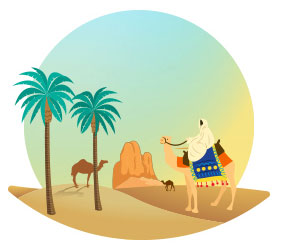Umm Kulthum, Daughter of Abu Bakr As-Siddiq
Umm Kulthum, Daughter of Abu Bakr As-Siddiq (1): Umm Kulthum Bint Abi Bakr As-Siddiq Bin Abi Quhafa Bin Aamer Bin ‘Amr Bin Kaab Bin Saad Bin Taym.
Umm Kulthum’s mother was Habiba Bint Kharija Bin Zaid Bin Abi Zuhair Bin Malik Bin Imru’ al-Qais Bin Malik Al-Aghar Bin Thalaba Bin Kaab Bin Al-Khazraj Bin Al-Harith Bin Al-Khazraj, whose brother, Zaid Bin Kharija, spoke after death.
When she grew older, Umar, may Allah be pleased with him, asked Aisha, may Allah be pleased with her, for Umm Kulthum’s hand in marriage. She gave him her blessing, but Umm Kulthum disliked the idea due to Umar’s harsh lifestyle and said she wanted a young man with a more easy-going lifestyle. She ended up marrying Talha Bin Ubaydullah Bin Uthman Bin ‘Amr Bin Kaab Bin Saad Bin Taym and bore him Zakariya, Yusef (who died young), and Aisha Bani Talha.
Talha Bin Ubaydullah was killed during the Battle of the Camel, after which Umm Kulthum married Abdel-Rahman Bin Abdullah Bin Abi Rabi’ah Bin Al-Mughirah Al-Makhzumi and bore him: Ibrahim Al-Ahwal, Musa, Uthman, Um Humayd, and Umm Uthman.
Aisha, the Mother of the Believers, sent Salim Bin Abdullah Bin Umar to Umm Kulthum to nurse him in order to establish a foster-relationship that would allow him to enter upon her and sit freely in her presence, but she only nursed him three times before falling ill.
Umm Kulthum’s father, Abu Bakr As-Siddiq, passed away while her mother was still pregnant with her. At one point, when speaking to Aisha, he made reference to “your two brothers and your two sisters,” whereupon Aisha said: “Here is Asma, but who is the other one?” He said: “What’s in the womb of Kharija’s daughter. I think it will be a girl, so take good care of her.”
Umm Kulthum narrated on the authority of her sister, Aisha, the Mother of the Believers, while her son, Ibrahim Bin Abdel-Rahman Bin Abdullah Bin Abi Rabi’ah, Jaber Bin Abdullah Al-Ansari, Talha Bin Yahya Bin Talha Bin Ubaydullah, and others all narrated on her authority. Bukhari included her narrations in Kitab Al-Adab, and Muslim, An-Nasa’i, and Ibn Majah all included her narrations in their collections as well. She died sometime between 41 and 50 AH.
Source: Kitab Al-Sulala Al-Bakria As-Siddiqia – Part II, by Ahmed Farghal Al-De’abassi Al-Bakri
Date of Publication
1 Ramadan 1438 AH / May 26, 2017 AD
(1) Al-Tabaqat Al-Kubra, Al-Elmia Ed. 8/ 337, Tarikh Al-Islam, Bashar Ed. 2/ 449, Tahdhib Al-Kamal fi Asma’ Al-Rijal 35/ 380, Maghani Al-Akhyar fi Sharh Asami Rijal Ma’ani Al-Athar 3/ 497, Jamharat Nasab Quraysh wa Akhbariha 2/ 605, Al-Tabieen fi Ansab Al-Qurashieen 1/ 281, A’lam Al-Nissa’ fi ‘Alami Al-Arab wa Al-Islam 4/ 250-251
